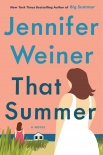That Summer, Jennifer Weiner [sites to read books for free txt] 📗

- Author: Jennifer Weiner
Book online «That Summer, Jennifer Weiner [sites to read books for free txt] 📗». Author Jennifer Weiner
One night in December, Michael Carmody came to the Abbey for dinner, accompanied by a pretty young woman who wore dangly gold earrings and a dress of peach-colored silk. Diana could have never worn that color, but the shade made the woman’s pale, luminous white skin seem to glow. Reese winked at Diana as he seated them in her section. Diana shot him a dirty look, but before she could head over with menus and bread and glasses of water, Ellie had swooped in, smiling and chattering, greeting Michael with a hug. “I’ve got this,” she called to Diana.
Diana told herself that it didn’t matter. She returned Michael Carmody’s friendly wave, and tried not to watch as he held the woman’s chair out for her, or to listen as her laughter rang out across the dining room. When she walked by to deliver desserts to a four-top, an hour later, Michael and the woman were talking intently, their voices low, leaning so close to one another that their foreheads were practically touching, and he never even looked her way as he escorted his lady friend out the door. Well, she thought, that’s that.
Jane, a fellow dog walker, told Diana where to get her shellfishing permit, and taught her how to use a clam rake. All through January and February, every few weeks, at low tide, Diana would walk Willa out onto a sandbar. Willa would run, chasing gulls, while Diana, in wool socks and rubber boots and a puffy down coat, raked the sand, listening for the telltale clinking sound of shells against the rake’s tines, and filled the wire bucket with clams. One weekend Jane, who was short, with cropped gray hair and clear blue eyes, took her to Pamet Harbor and showed her how to pry oysters off the rocks with a knife. Back at home, Jane watched, supervising, as Diana struggled to pry the shells open, finally managing to free six mangled oysters from their homes. She poured herself a beer and sliced a lemon into wedges, arranged the oysters on a platter, and ate them, with lemon juice and cocktail sauce, while she and Willa and Jane and Jane’s Bernese mountain dog, Thatcher, sat on the deck in the thin winter sunshine.
She went oystering all through the winter, dressing in layers, with canvas gardening gloves on her hands and a wool cap pulled down over her ears. She tossed the shells into a heap at the corner of the deck, thinking about her summer with Dr. Levy, the way that she would boil the shells until they were clean, then throw them onto the driveway. “Okay, kids, do your thing!” she’d call, and Sam and Sarah would race outside to stomp on the shells, jumping up and down, crushing them to bits.
By March, her heap was almost knee-high. Diana thought about dropping some off as an offering, as a combination thank-you and hello, but she knew she couldn’t. Even seeing the house would be too much. She picked up a shell and held it in her hand, turning it over, admiring its shape and the shades of cream and gray on its inner curve, underneath where the oyster had lain. She looked at them until she had an idea. Then it was just a matter of gathering supplies.
She found paper napkins in the clearance bin at one of the fancy home goods stores in P-town. “With the summer people gone,” said the proprietor, “there’s not much call for cocktail supplies.” Diana bought a pack of napkins with a pattern of blue anchors and seashells on the white background, and bought gold paint, white paint, and Mod Podge at the hardware store on Conwell Street.
Back at the cottage, she gave the shells a soak in vinegar, and dried them in the sun. When they were dry, she picked the largest shell and painted its insides white, and then, with a fine brush, painted a layer of gold around its rim. When the paint had dried, she brushed on a layer of Mod Podge, then carefully peeled the two-ply napkins apart and pressed the colorful side into the shell. She trimmed off the extra, lacquered the paper, and rubbed the edges with fine-grained sandpaper. “See that?” she asked Willa, extending her creation for the dog’s perusal. “It’s a dish for my necklaces and earrings.”
Willa sniffed the shell dubiously, and gave Diana a hopeful look. Diana tossed her the last of Mike Carmody’s dehydrated hot dog rounds, and then, after painting and decoupaging the rest of the shells, she lined them up in a row. They were brightly colored, their gold rims vivid. From a distance, they looked like flowers, pinks and creams, reds and golds, unfolding in the sun.
10 Diana
On the last day of March, Diana woke up one morning to find the cottage so cold that she could see her breath. She wrapped her down comforter around her and padded, barefoot, down the stairs and over to the thermostat, which said that it was fifty-two degrees. She bent to put her hand down against the vent and felt no warmth, and no matter how many times she turned the thermostat’s switch off and then on again, the





Comments (0)